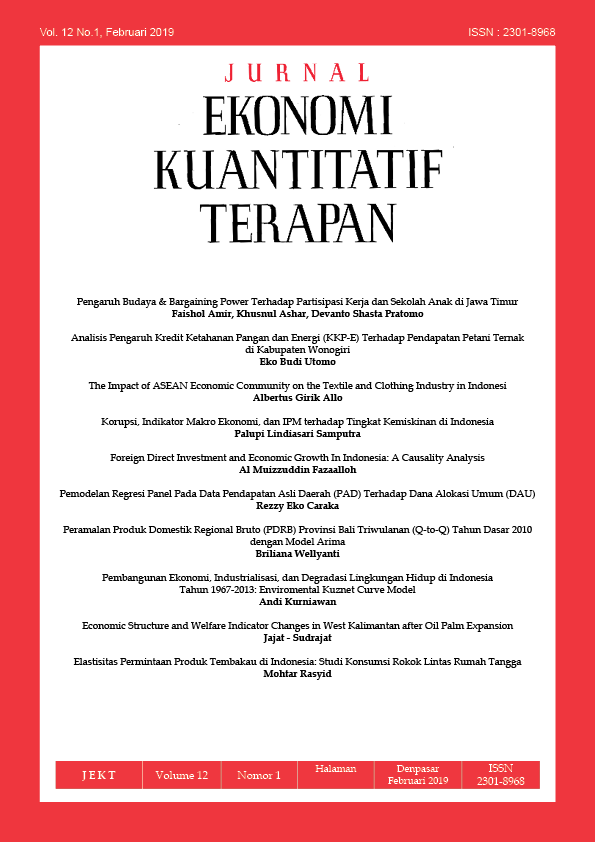Economic Structure and Welfare Indicator Changes in West Kalimantan after Oil Palm Expansion
Abstract
This study aimed to analyze the economic structure changes of regencies and cities in West Kalimantan after a massive expansion of oil palm plantations, to analyze the economic sectors that have competitive advantages, and to analyze the impact of various changes on social welfare. The study was conducted by collecting data about employment and some welfare indicators at the statistic central bureau. Data were analyzed by using the shift-and-share and also descriptive method. This study concludes that regional autonomy and oil palm expansion policy have a positive impact on economic structure changes either in regencies or Pontianak. The economic sectors that have a competitive advantage in the regencies are agriculture, electric/gas/water, transport and communication, trade/hotel/restaurant, and services. Meanwhile, in Pontianak, there are agriculture, transport and communication, manufacturing industry, and electric/gas/water sectors. Economic structure changes also show positive impacts on social welfare. It is marked by the decline of poverty rate in Pontianak and the province as a whole. In addition, it is also signalled by the improvement of Human Development Index (HDI) and Gross Regional Domestic Product (GRDP) per capita in the regencies, Pontianak, and the province. Meanwhile, its impact toward poverty reduction in regency level does not show significant results yet.
Downloads
References
Akkoyunlu, S. (2015). The Potential of Rural Urban Linkage for Sustainable Development and Trade. International Journal of Sustainable Development & World Policy, 4(2), 20-40.
Blair, J.P. (1991). Urban and Regional Economics. Boston, USA: Richard D Irwin, INC.
BPS. (2014). Direktori Perusahaan Perkebunan. Jakarta: Badan Pusat Statistik Indonesia
Budidarsono, S., S. Dewi, M. Sofiyuddin, and A. Rahmanulloh. (2012a). Socioeconomic Impact Assessment of Palm Oil Production. Technical Brief No. 27: Palm Oil Series. Bogor, Indonesia: World Agroforestry Centre-(ICRAF), SEA Regional Office. 4p.
Budidarsono, S., A. Rahmanulloh, and M. Sofiyuddin. (2012b). Economic Assessment of Palm Oil Production. Technical Brief No. 26: Palm Oil Series. Bogor, Indonesia: World Agroforestry Centre-(ICRAF), SEA Regional Office. 6p.
Budidarsono, S., A. Susanti, and A. Zoomers. (2013). Oil Palm Plantation in Indonesia: The Implication for Migration, Settlement/Resettlement and Local Economic Development. Available at: http://dx.doi.org/10.5772/53586. Accessed on August 29, 2016.
Bulderberga, Z. (2011). Rural-Urban Partnership for Regional Development. Socialiniai tyrimai/Social Research, 1(22), 14-24.
De Zeeuw, H., R. Van Veenhuizen, and M. Dubbeling. (2011). The Role of Urban Agriculture in Building Resilient Cities in Developing Countries. Journal of Agricultural Science, 1-11.
Douglass, M. (1998). A Regional Network Strategy for Reciprocal Rural-Urban Linkage: An Agenda for Policy Research with Reference to Indonesia. Third World Planning Review, 20(1), 1-34.
Elias, S. and C. Noone. (2011). The Growth and Development of the Indonesian Economy. Buletin, (December Quarter), 33-43.
Ghalib, R. (2005). Ekonomi Regional. Cetakan Pertama. Bandung: Pustaka Ramadhan.
Maulana, R. dan P.A. Bowo. (2013). Pengaruh Pertumbuhan Ekonomi, Pendidikan dan Teknologi terhadap IPM Provinsi di Indonesia 2007 – 2011. Jejak: Journal of Economics and Policy, 6(2), 163-169.
Mukti, A., B. Setiawan, H. Pramudyo, and L. Fatah. (2014). The Impact of Palm Oil Plantation Development towards Income Disparity. Academic Research International, 5(2), 96-106.
Obidzinski, K., R. Andriani, H. Komarudin, and A. Andrianto. (2012). Environmental and Social Impact of Oil Palm Plantation and Their Implications for Biofuel Production in Indonesia. Ecology and Society, 17(1), 25-43.
OECD. (2010). Economic Importance of Agriculture for Sustainable Development and Poverty Reduction: Finding from A Case Study of Indonesia. Available at: http://www.oecd.org/agriculture/agriculture-policies/46341215 pdf. Accessed on September 4, 2016.
PASPI. (2016). Mitos vs Fakta Industri Minyak Sawit Indonesia dalam Isu Sosial, Ekonomi, dan Lingkungan Global. Edisi Kedua. Bogor: PASPI (Palm Oil Agribusiness Strategic Policy Institute).
Rahmat, M. (2011). Potensi Lahan Pertanian Perkotaan dalam Penyediaan Pangan, dalam: Badan Penelitian dan Pengembangan Pertanian-Kementerian Pertanian, Membangun Kemampuan Pengelolaan Lahan Pertanian Pangan Berkelanjutan. Bogor: IPB Press, pp. 139-152.
Sjafrizal. (2012). Ekonomi Wilayah dan Perkotaan. Cetakan Pertama. Jakarta: PT RajaGrafindo Persada.
Suryahadi, A., D. Suryadarma, and S. Sumarto. (2009). The Effect of Location and Sectoral Components of Economic Growth on Poverty: Evidence from Indonesia. Journal of Development Economics, 89, 109-117.
Susila, W.R. (2004). Contribution of Oil Palm Industry to Economic Growth and Poverty Alleviation in Indonesia. Jurnal Litbang Pertanian, 23(3), 107-114.
Syahza, A. (2011). Percepatan Ekonomi Pedesaan Melalui Pembangunan Perkebunan Kelapa Sawit. Jurnal Ekonomi Pembangunan, 12(2), 297-310.
Tarigan, R. (2005). Ekonomi Regional Teori dan Aplikasi. Edisi Revisi. Jakarta: PT Bumi Aksara.
World Growth. (2011). The Economic Benefit of Palm Oil to Indonesia. Available at: http://worldgrowth.org/site/wp-content/uploads/2012/06/WG_Indonesian_Palm_Oil_Benefits_Report-2_11. pdf. Accessed on August 29, 2016.




















